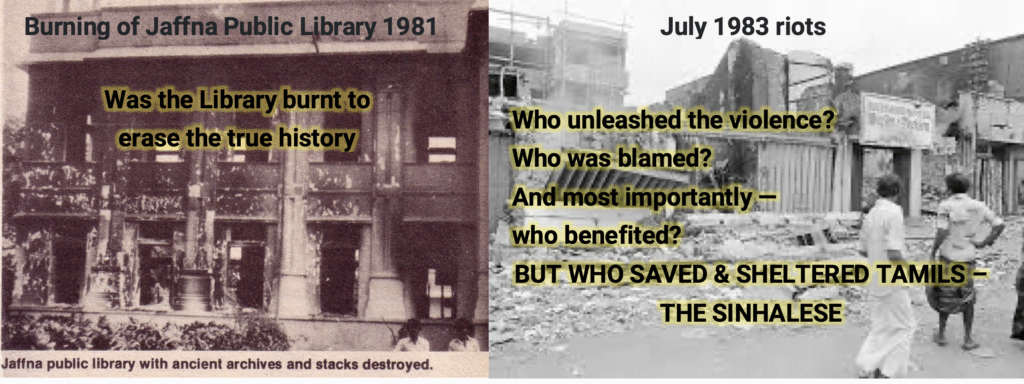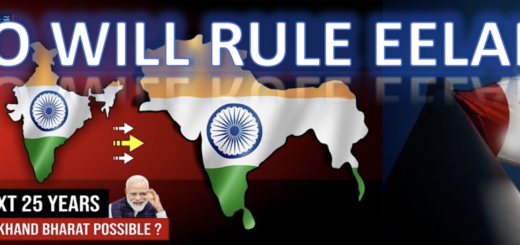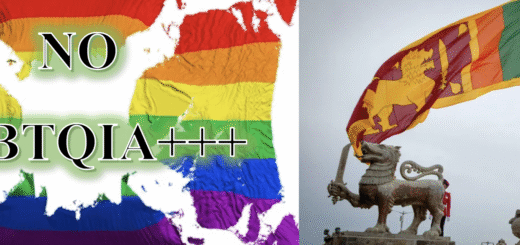Revisiting July 1983: from caste rebellion to ethno-secession – who really orchestrated Tamil Militancy?

The popular narrative around Sri Lanka’s conflict centers on 1983 — the so-called “Black July” — as the spontaneous ignition point for Tamil militancy. But this version of events is dangerously misleading. In truth, Tamil militancy did not evolve organically in Sri Lanka. It was conceived, trained, and funded by India for its own geopolitical objectives, long before the riots of 1983. The armed struggle was merely branded as ethnic, when in fact its early roots lie in caste oppression within Tamil society and foreign strategic manipulation.
India’s Hidden Hand: Training Tamil Militants for Geopolitical Leverage
By the late 1970s, India’s intelligence agency RAW had begun training Tamil youth in Tamil Nadu and other South Indian locations. Groups like LTTE, TELO, EPRLF, and EROS were nurtured, funded, and armed — not to save Tamils, but to use them as geopolitical pawns against Sri Lanka, which was increasingly tilting toward the West and liberalizing its economy.
This was not a liberation struggle born on Sri Lankan soil.
It was a proxy war, externally engineered by India to destabilize a sovereign neighbour for its regional supremacy, not to resolve internal Tamil grievances
India used the guise of “protecting Tamils” to create leverage.
This culminated in the Indo-Lanka Accord (1987), the deployment of the Indian Peace Keeping Force (IPKF), tweaking of Sri Lanka’s Constitution introducing the 13th amendment & the Provincial Council system, and the annexation-style merger of the North and East — all moves designed to serve Indian strategic and economic interests, not solving any problems of Tamils.
Caste — Not Ethnicity — fueled the early Tamil Rebellion
The first real alienation experienced by Prabhakaran and other Tamil youth came not from the Sinhalese, but from within their own community.
Tamils were being oppressed by their own – not the Sinhalese.
- Tamil society, particularly in Jaffna, was deeplycaste-ridden, with Vellalar elites dominating religion, education, land, and politics.
- Lower-caste Tamils likePallars, Nalavars, and Paraiyars were denied access to temples, schools, salons, and even water wells.
Bandaranaike’s 1957 Social Disabilities Act
In a stunning move that angered high-caste Tamils, Prime Minister S.W.R.D. Bandaranaike passed the Social Disabilities Act, giving lower-caste Tamils the right to access education and public spaces.
It was the first legal empowerment granted to oppressed low-caste Tamils — not by Tamil elites, but by a Sinhalese leader.
- High-caste Tamil elites opposed this Act so vehementlythat they travelled by ship to petition the British Privy Council in London to annul it — as Sri Lanka was still a Dominion the Privy Council was its highest appellate court until 1972.
- This clearly revealed that Tamil elites werenot interested in equality amongst their own, but in preserving a caste-dominated status quo.
Ironically, it was the Sinhalese-led government that gave low-caste Tamils their first taste of social justice — not the Tamil elites who would later claim to champion their freedom.
The 1981 Burning of Jaffna Library: A convenient erasure of History?
The burning of the Jaffna Public Library in 1981 — widely blamed on Sinhala mobs — occurred two years before the 1983 riots. But its strategic timing and disproportionate consequences raise deeper questions:
- The library housed over95,000 irreplaceable manuscripts, including palm-leaf documents and historical records that may have discredited the myth of an ancient Tamil kingdom and instead validated historical records of colonial-era plantation migration and South Indian settler origins.
- Its destructioncleared the path for promoting the myth of an ancient Tamil homeland—a foundational claim for separatism that India and Tamil militants were preparing to promote on the world stage.
Qui bono? Who benefited?
The principle of cui bono invites us to examine whether those blamed actually benefited — or whether the true perpetrators were those who gained most.
Here, it was not the Sinhalese population or the Sri Lankan state that gained anything from the erasure of Tamil historical records.
The real beneficiaries were the LTTE, Tamil separatist elites, LTTE diaspora propagandists and India — all of whom stood to gain from destroying contradictory evidence.
Res ipsa loquitur — the thing speaks for itself.
When we consider the timing, motive, and outcomes, the event itself raises doubts about the official story.
The possibility of a false flag operation — a deliberate act to pin blame on another party while advancing your own goals — must be seriously considered.
1983 Riots: A Pretext, not a Cause
The ambush and killing of 13 Sri Lankan soldiers by the LTTE in July 1983 was no isolated event. It was a strategic provocation that triggered horrific violence — not spontaneously, but with suspicious orchestration. Gangs descended on Tamil homes and businesses, not out of ethnic rage, but with the intent to loot — much like the organized mobs that destroyed homes & property during the 2022 aragalaya protests.
So the real questions are:
Who unleashed the violence?
Who was blamed?
And most importantly — who benefited?
What followed was used as the perfect justification to:
- Unleash India-trained Tamil militants into public view.
- Shift global blame onto the Sri Lankan government and Sinhalese majority.
- Manufacture aglobal sympathy campaign for the Tamil separatist agenda.
Once again, we must ask: Cui bono?
Who profited from these riots? Certainly not the average Sinhalese citizen — many of whom risked their lives to protect Tamil neighbors.
Nor the Sri Lankan state, which became the subject of global condemnation.
Once again, the real victors were:
- India, which now had a humanitarian pretext for diplomatic intervention.
- Tamil militant groups, who finally had international visibility.
- AndTamil elites, who used the chaos to facilitate asylum and diaspora expansion.
Under the maxim “Falsus in uno, falsus in omnibus” (false in one thing, false in all),
If the 1983 riots were a staged political operation, not a spontaneous ethnic clash, then everything built on that lie — separatism, asylum claims, and foreign pressure — must be questioned.
Moreover, the organized coordination of the rioters, the precision of the attacks, and the disproportionate refugee claims by those untouched by violence further prove that this was not a spontaneous, grassroots Sinhala uprising against Tamils — but something far more engineered and exploitative.
Fraus est celare fraudem — it is fraud to conceal a fraud.
When narratives are actively manipulated, when truths are selectively buried (such as Sinhalese civilians saving Tamils), and when global discourse is shaped by political actors, we are not witnessing organic conflict but engineered crisis.
Thimpu Talks to Indo-Lanka Accord: India’s Agenda on Full Display
India’s sponsorship of Tamil militancy culminated in the Thimpu Talks (1985) and the Indo-Lanka Accord (1987) — both framed as peace initiatives, but filled with strategic takeovers.
- India insisted on themerger of the North and East — a move with no real benefit to Tamils but massive geopolitical gain for India.
- TheProvincial Council system and land devolution enabled external interference in internal governance. Prabakaran was against 13th
- India pushed for control over strategic assets like theTrincomalee Oil Tanks (a war time strategic asset) along with exclusive development rights to energy corridors & ports, under the guise of helping Tamils.
None of these provisions addressed caste discrimination, Tamil livelihoods, or rural development. This wasn’t Tamil empowerment — it was Indian entrenchment.
Why did Prabhakaran kill Rajiv Gandhi?
By 1991, Prabhakaran had realized India’s betrayal.
After manipulating the Tamil movement, India:
- Deployed the IPKF, which committedatrocities against Tamil civilians
- Sought toforce the LTTE into submission – orders were even given to assassinate Prabakaran (IPKF Generals memoirs)
- Abandoned Tamils once India’s strategic objectives were met
Rajiv Gandhi’s assassination was revenge, not just personal but symbolic — for India’s betrayal of the very militants it created. Ironically, it was Rajiv’s mother Indira Gandhi who gave the nod to train Sri Lankan Tamil militants.
The LTTE-Western NGO Alliance: Faith-Based Fronts for Propaganda
Post-Rajiv, the LTTE increasingly relied on Western funding and faith-based NGOs, many of which operated in the North and East:
- Catholic priests and nunswere at the forefront of protests and international campaigns.
- NGOs and INGOs helped sustain the LTTE’sglobal propaganda machine, especially in the diaspora. LTTE fronts opened office & operated from Western capitals.
This alliance ensured that the LTTE’s image shifted from terrorist group to “freedom fighters”, whitewashing decades of atrocities, child soldier recruitment, and ethnic cleansing.
Separatism: An Elitist Agenda hijacked by Militants
The call for a separate Tamil state did not begin with the LTTE.
It was first made by Tamil elites:
- The1949 establishment of the Ilankai Tamil Arasu Kachchi (Federal Party)
- The1976 Vaddukoddai Resolution, drafted by Tamil politicians—not fighters—calling for a separate state
The LTTE hijacked this elitist political demand, militarized it, and used caste-oppressed youth as cannon fodder, claiming they fought for Tamil rights.
The Greatest Betrayal was Not Sinhalese vs Tamils — But Tamils used by India
The 1983 riots were not the beginning of the Tamil struggle.
They were the perfect excuse to activate a movement already years in the making, designed not for Tamil freedom but for India’s regional control.
- India trained and armed Tamil militantsas early as the late 1970s to destabilize Sri Lanka and counterbalance U.S.-leaning foreign policy.
- Elitist Tamil politicians seeded the idea of separatismwell before the LTTE was born, hoping to preserve caste and class privilege.
- The West exploited the chaosto absorb asylum-seekers, weaponize diaspora lobbying using their trump cards “human rights” “accountability”, and pressure Sri Lanka geopolitically.
- Caste-oppressed Tamil youth became expendable tools—first used by Indian intelligence, then by the LTTE, and later as poster victims for international NGOs.
Post-LTTE Defeat: India’s Strategic Capture of Sri Lanka’s Sovereignty
Under the pretext of “Tamil welfare” and post-war rehabilitation, India has entrenched itself in critical sectors island-wide—far beyond the North and East.
- Trincomalee Oil Tank Farm– 50-year lease granted to India’s Lanka IOC for 61 tanks; 14 tanks under full Indian control.
- Northern Railway Lines– Rs. 416 million Line of Credit used to rebuild Omanthai to Pallai and Madhu to Talaimannar segments.
- Jaffna International Airport– Revived and funded by India; Chennai–Jaffna flights established.
- Kankesanthurai Port– Modernized via Indian grants; India now runs a direct ferry service from Tamil Nadu.
- Sampur Solar Power Plant– India building large-scale solar project in Trincomalee district.
- India–Sri Lanka Power Grid and LNG Supply– Energy interdependence initiatives via MOU, bringing grid connectivity and pipeline control under Indian influence.
- Digital Infrastructure Takeover– Introduction of India’s UPI payment system, Aadhaar-linked digital identity services, and cloud/data integration across Sri Lanka, including biometric-based NIC registration. This hands India access to Sri Lankan citizens’ private data—including identity, finance, and biometrics—posing serious digital sovereignty and privacy threats under the guise of “tech assistance.” It also raises red flags about data sovereignty, cyber-surveillance risks, and AI-modelled voter behavior manipulation.”
- Defence Production & Maritime Foothold– Mazagon Dock (India) acquiring Colombo Dockyard; India’s shipbuilding and naval repair embedded within Sri Lanka’s primary maritime facility.
- Mattala Airport (South)– Indian (with Russian) companies given 30-year operational control of Chinese-built airport.
- Housing, Tea Estate Development, and Vehicles– India funded 46,000+ homes, gifted 500 SUVs and 22 locomotives, and entered tea plantation welfare schemes across Central Sri Lanka.
- Currency Swap & Customs Linkage– India extended multiple currency‑swap lines (US $400M to $1B) to Sri Lanka during its financial crisis, tightly linking fiscal stability to Indian goodwill. India also pushed customs and trade integration frameworks. Sri Lanka’s central banking mechanisms are increasingly exposed to Indian monetary policy and fintech tools — a soft economic annexation.
- Defence & Security MoU (2025)– A new 5‑year umbrella agreement institutionalizes joint military exercises (SLINEX, MITRA SHAKTI), defence training, humanitarian assistance, naval port access, intelligence sharing, and operational synergy. Sri Lanka must also ensure its territory is not used against Indian interests.
- Maritime Rescue Coordination Centre & Surveillance– Built under Indian grant; Indian Navy Dornier aircraft and Goa Shipyard floating dock deployed at Trincomalee for maritime security.
- Maritime Boundary & Mining Rights– India pressured Sri Lanka to withdraw support for its continental shelf extension, then submitted its own ISA coastal mineral extraction applications, potentially encroaching on Sri Lanka’s seabed rights. India’s exploration interests in rare earth minerals and deep-sea mining pose a threat to Sri Lanka’s unexploited maritime wealth — especially with UNCLOS protections now bypassed via bilateral pressure.
- Sea‑Grid Interconnect & Energy Pipeline– Agreements on India‑Sri Lanka power grid HVDC link and LNG-pipeline connectivity, making Sri Lanka energy-dependent and infrastructure-integrated with India.
- Economic & Trade Integration– Negotiations resumed on Economic‑Technology Cooperation Agreement (ETCA) to facilitate goods, services, and digital public infrastructure integration.
- Strategic Ports & Connectivity– Modernization of Kankesanthurai (Jaffna) port and direct ferry link to Tamil Nadu; lobbying for Trincomalee container terminals and terminals; India pushing research vessel restrictions targeting Chinese access.
Analytical Interpretation
- India benefits: not Tamil communities. India has economically, militarily, and digitally—embedding itself in Sri Lanka’s sovereignty acrossfinance energy, maritime, defence, digital infrastructure, and resource exploitation.
- These projects go beyond regional development; they representsystemic Indian entrenchment, effectively using the Tamil question as a strategic pretext.
Cui bono – who benefits?
India, not Tamils, is the long-term beneficiary of this takeover.
The Tamil “struggle” became the moral cover for a comprehensive Indian expansion strategy—from ports and airports to power, defense, and digital systems.
History must be told in full — not in fragments that serve only those who engineered the tragedy.
What have Tamils to say now? Is India better than the Sinhalese?
After decades of sacrifice, displacement, and betrayal, Tamil citizens must now ask: Were they liberated — or merely transferred from one master to another?
Has India proven a better ally than the Sinhalese — or simply a more strategic manipulator?”
Shenali D Waduge







